A Compact and Wideband Beam-Scanning Antenna Array Based on SICL Butler Matrix
Abstract
1. Introduction
2. Design of Cavity-Backed Ridged Hybrid Horn Antenna Element
3. Design of Compact 4 × 4 Rotationally Symmetric Butler Matrix Based on SICL
3.1. Wideband 3 dB Three-Branch-Line Coupler with DGS
3.2. WR-15-to-SICL Transition
3.3. 4 × 4 SICL Butler Matrix
4. Design of Non-Uniform Double-Ridged Horn Antenna Array
5. Measurement and Discussion
6. Conclusions
Author Contributions
Funding
Data Availability Statement
Acknowledgments
Conflicts of Interest
References
- Roh, W.; Seol, J.-Y.; Park, J.; Lee, B.; Lee, J.; Kim, Y.; Cho, J.; Cheun, K.; Aryanfar, F. Millimeter-wave Beamforming as An Enabling Technology for 5G Cellular Communications: Theoretical Feasibility and Prototype Results. IEEE Commun. Mag. 2014, 52, 106. [Google Scholar] [CrossRef]
- Butler, J.; Lowe, R. Beamforming matrix simplifies design of electronically scanned antennas. Electron. Des. 1961, 9, 170. [Google Scholar]
- Ren, H.; Zhang, H.; Jin, Y.; Gu, Y.; Arigong, B. A Novel 2-D 3×3 Nolen Matrix for 2-D Beamforming Applications. IEEE Trans. Microw. Theory Tech. 2019, 67, 4622. [Google Scholar] [CrossRef]
- Tseng, C.H.; Chen, C.J.; Chu, T.H. A Low-Cost 60-GHz Switched-Beam Patch Antenna Array with Butler Matrix Network. IEEE Antennas Wirel. Propag. Lett. 2008, 7, 432. [Google Scholar] [CrossRef]
- Yang, Q.-L.; Ban, Y.-L.; Lian, J.-W.; Yu, Z.-F.; Wu, B. SIW Butler Matrix with Modified Hybrid Coupler for Slot Antenna Array. IEEE Access 2016, 4, 9561. [Google Scholar] [CrossRef]
- Xiao, J.; Li, X.; Zhu, H.; Feng, W.; Yao, L. Micromachined Patch Antenna Array Design and Optimization by Using Artificial Neural Network. IEICE Electron. Express 2017, 14, 20170031. [Google Scholar] [CrossRef]
- Ma, L.; Wu, Y.; Wang, W. Design of Wideband Butler Matrix with Equal/Unequal Phase Differences for Flexible Beam-Controllability. IEEE Trans. Circuits Syst.-II Express Briefs 2021, 68, 3537. [Google Scholar] [CrossRef]
- Van Messem, L.; Moerman, A.; Caytan, O.; de Paula, I.L.; Hoflack, B.; Stroobandt, B.; Lemey, S.; Moeneclaey, M.; Rogier, H. A 4 × 4 Millimeter-wave Frequency Butler Matrix in Grounded Co-Planar Waveguide Technology for Compact Integration with 5G Antenna Arrays. IEEE Trans. Microw. Theory Tech. 2023, 71, 122. [Google Scholar] [CrossRef]
- Tian, G.; Yang, J.-P.; Wu, W. A Novel Compact Butler Matrix without Phase Shifter. Microw. Wirel. Compon. Lett. 2014, 24, 306. [Google Scholar] [CrossRef]
- Wu, Q.; Hirokawa, J.; Yin, J.; Yu, C.; Wang, H.; Hong, W. Millimeter-wave multibeam endfire dual-circularly polarized antenna array for 5G wireless applications. IEEE Trans. Antennas Propag. 2018, 66, 4930. [Google Scholar] [CrossRef]
- Vallappil, A.K.; Rahim, M.K.A.; Khawaja, B.A.; Murad, N.A.; Mustapha, M.G. Butler Matrix Based Beamforming Networks for Phased Array Antenna Systems: A Comprehensive Review and Future Directions for 5G Applications. IEEE Access 2021, 9, 3970. [Google Scholar] [CrossRef]
- Lian, J.-W.; Zhao, X.-Y.; Ban, Y.-L.; Liu, Y.; Nie, Z. Compact SIW 2-D Butler Matrix and Its Multibeam Application. IEEE Antennas Wirel. Propag. Lett. 2021, 20, 386. [Google Scholar] [CrossRef]
- Wu, M.; Zhang, B.; Zhou, Y.P.; Huang, K.M. A Double-Fold 7 × 8 Butler Matrix-Fed Multibeam Antenna with a Boresight Beam for 5G Applications. IEEE Antennas Wirel. Propag. Lett. 2022, 21, 516. [Google Scholar] [CrossRef]
- Qiu, L.-L.; Zhu, L.; Ouyang, Z.-A.; Deng, L. Wideband Butler Matrix Based on Dual-Layer HMSIW for Enhanced Miniaturization. IEEE Microw. Theory Tech. Soc. 2022, 32, 25. [Google Scholar] [CrossRef]
- Afifi, I.; Sebak, A.R. Wideband 4×4 Butler Matrix in the Printed Ridge Gap Waveguide Technology for Millimeter-Wave Applications. IEEE Trans. Antennas Propag. 2020, 68, 7670. [Google Scholar] [CrossRef]
- Tekkouk, K.; Hirokawa, J.; Sauleau, R.; Ettorre, M.; Sano, M.; Ando, M. Dual-Layer Ridged Waveguide Slot Array Fed by a Butler Matrix with Sidelobe Control in the 60-GHz Band. IEEE Trans. Antennas Propag. 2015, 63, 3857. [Google Scholar] [CrossRef]
- Wang, C.; Yao, Y.; Cheng, X.; Zhu, Z.; Li, X. A W-Band High-Efficiency Multibeam Circularly Polarized Antenna Array Fed by GGW Butler Matrix. IEEE Antennas Wirel. Propag. Lett. 2021, 20, 1130. [Google Scholar] [CrossRef]
- Li, X.; Hou, Y.; Zhu, H.; Qi, Z.; Xiao, J.; Cao, C. A Broadband Beam Scanning Antenna Array Based on Substrate Integrated Coaxial Line Butler Matrix for Q-Band Application. Microw. Opt. Technol. Lett. 2019, 61, 2781. [Google Scholar] [CrossRef]
- Li, W.; Xu, J.; Zhao, R.; Hong, W. Compact Broadband Substrate-Integrated Coaxial Line 2-D Beamforming Network and Its Multibeam Array Antenna Applications. IEEE Trans. Microw. Theory Tech. 2024, 27, 262. [Google Scholar] [CrossRef]
- Iqbal, A.; Tiang, J.J.; Wong, S.K.; Alibakhshikenari, M.; Falcone, F.; Limiti, E. Miniaturization Trends in Substrate Integrated Waveguide (SIW) Filters: A Review. IEEE Access 2022, 8, 223287. [Google Scholar] [CrossRef]
- Lian, J.W.; Ban, Y.L.; Xiao, C.; Yu, Z.F. Compact Substrate-Integrated 4×8 Butler Matrix with Sidelobe Suppression for Millimeter-Wave Multibeam Application. IEEE Antennas Wirel. Propag. Lett. 2018, 17, 928. [Google Scholar] [CrossRef]
- Trinh-Van, S.; Lee, J.M.; Lee, K.Y.; Hwang, K.C. A Sidelobe-Reduced, Four-Beam Array Antenna Fed by a Modified 4×4 Butler Matrix for 5G Applications. IEEE Trans. Antennas Propag. 2019, 67, 4528. [Google Scholar] [CrossRef]
- Lian, J.W.; Ban, Y.L.; Zhu, J.Q.; Guo, J.; Chen, Z. Planar 2-D Scanning SIW Multibeam Array with Low Sidelobe Level for Millimeter-Wave Applications. IEEE Trans. Antennas Propag. 2019, 67, 4570. [Google Scholar] [CrossRef]
- Tsai, C.-E.; Jin, H.; Liao, C.-H.; Li, C.-Y.; Chang, W.-C.; Liu, H.-E.; Chin, K.-S. A 60 GHz Rhombic Patch Array Antenna with High Gain, Low Sidelobe Level, and Reduced Array Area. IEEE Access 2022, 10, 86498. [Google Scholar] [CrossRef]
- Zhao, H.J.; Chu, H.; Zhu, X.H.; Guo, Y.X. A Butler Matrix-Based Antenna Array with Improved Gain Flatness and Sidelobe Levels by Using Pattern-Reconfigurable Subarrays. IEEE Antennas Wirel. Propag. Lett. 2022, 21, 2477. [Google Scholar] [CrossRef]
- Wang, C.; Li, E.; Zhang, Y.; Guo, G. Ridged Horn Antenna with Adjustable Metallic Grid Sidewalls and Cross-Shaped Back Cavity. IEEE Antennas Wirel. Propag. Lett. 2015, 15, 1221. [Google Scholar] [CrossRef]
- Cao, Y.; Chin, K.-S.; Che, W.; Yang, W.; Li, E.S. A Compact 38 GHz Multibeam Antenna Array with Multifolded Butler Matrix for 5G Applications. IEEE Antennas Wirel. Propag. Lett. 2017, 16, 2996. [Google Scholar] [CrossRef]
- Gao, C.; Peng, J.J.; Rui, H.D.; Zhu, H.; Fan, S.T.; Qian, Z.F. Wideband 4 × 4 Butler Matrix Based Substrate Integrated Coaxial Line for Millimeter-Wave Applications. In Proceedings of the Cross Strait Radio Science & Wireless Technology Conference, Haidian, China, 17–18 December 2022. [Google Scholar] [CrossRef]
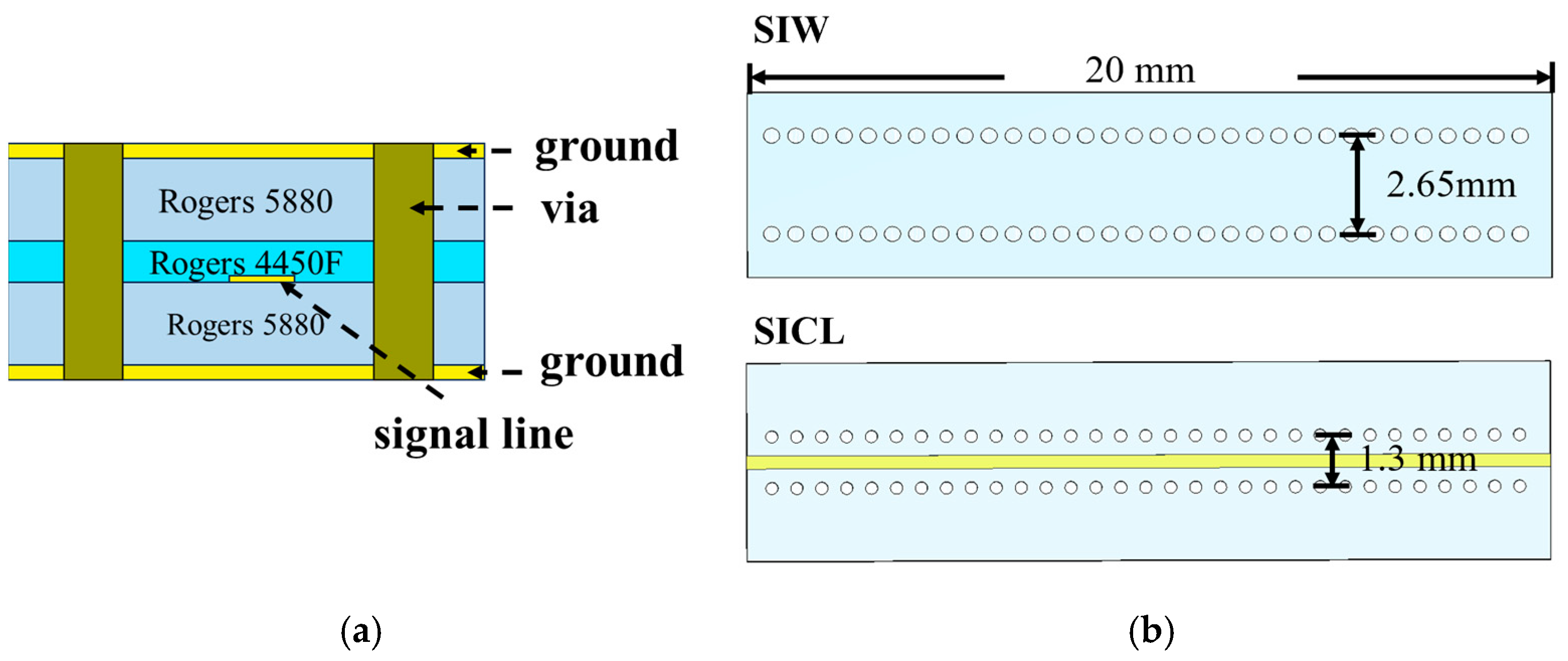

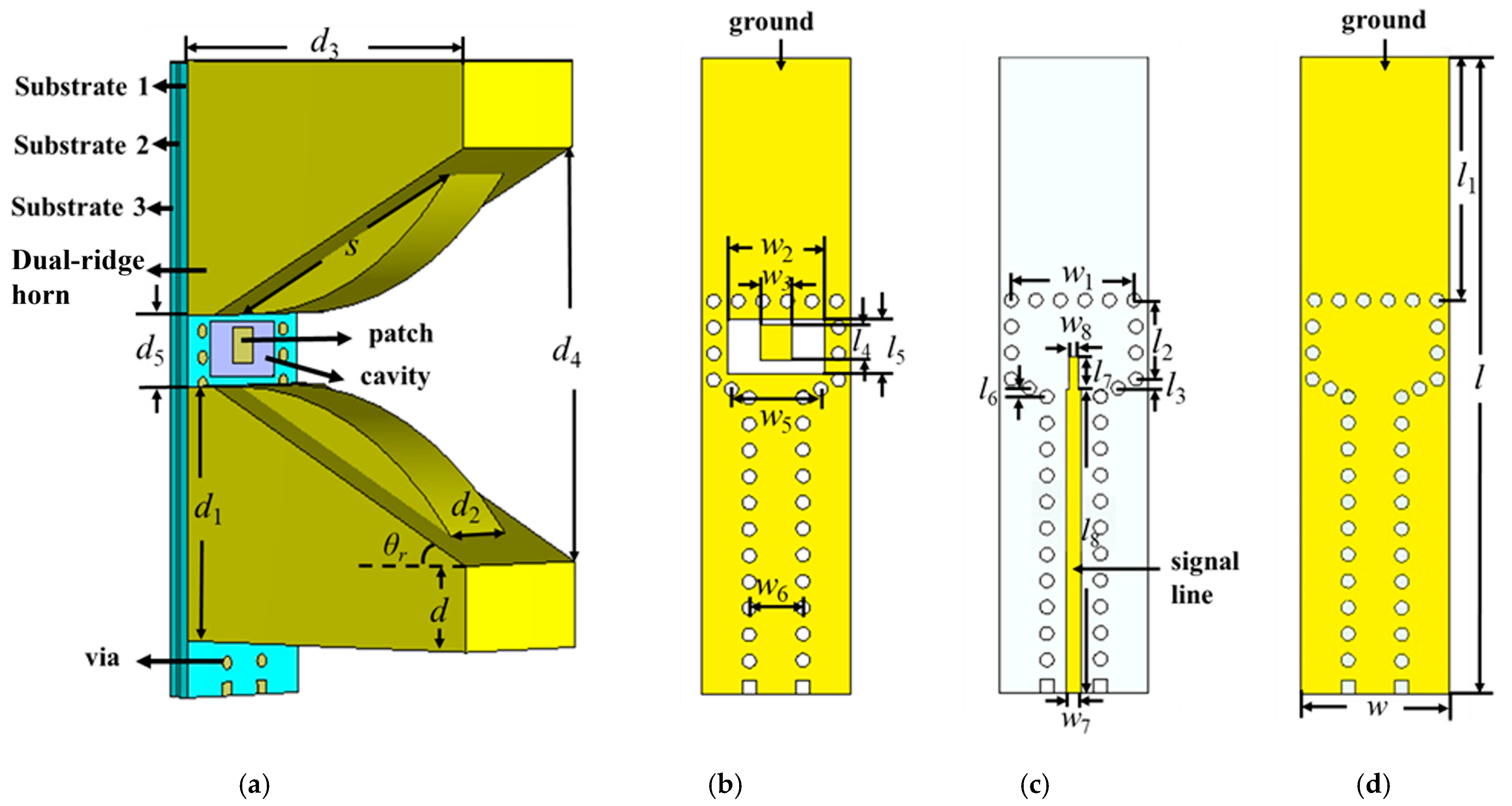
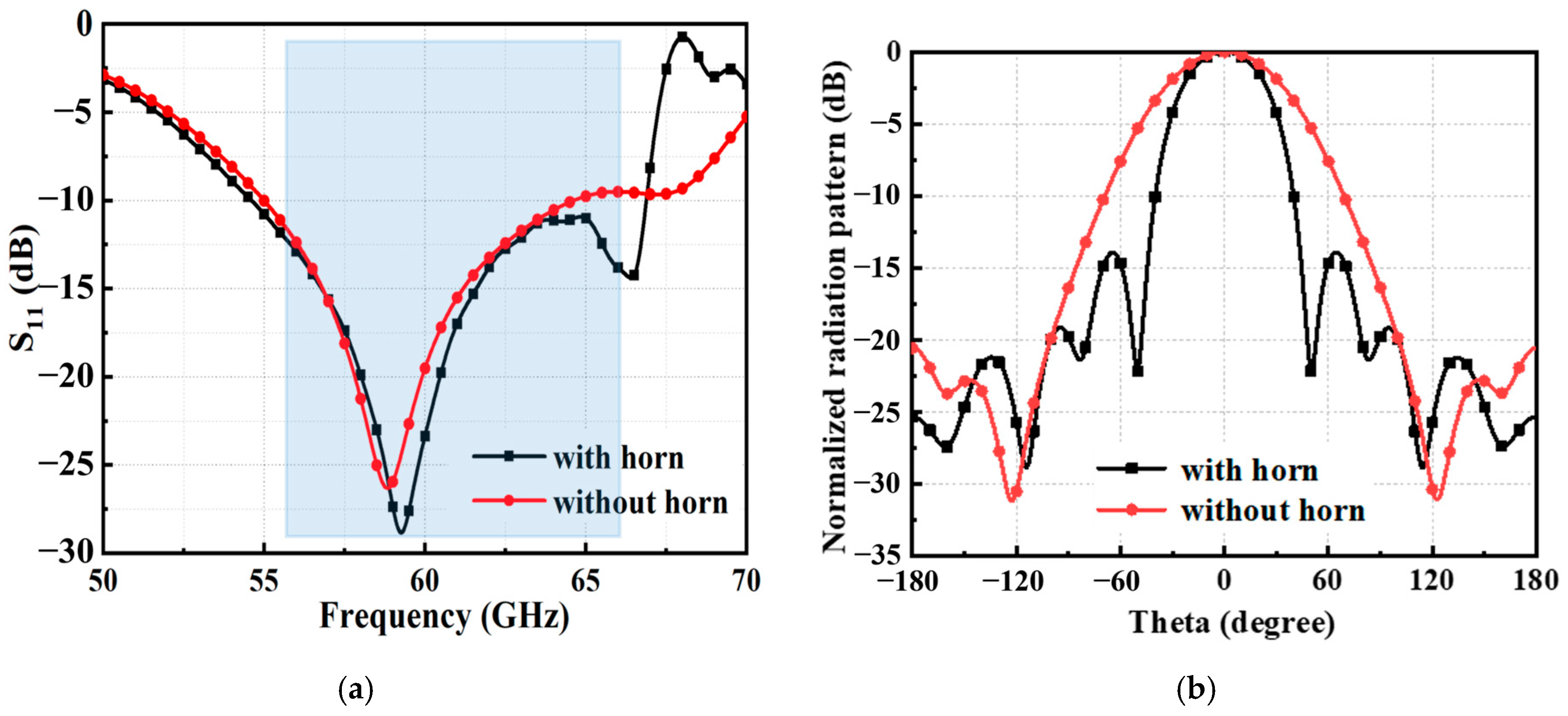
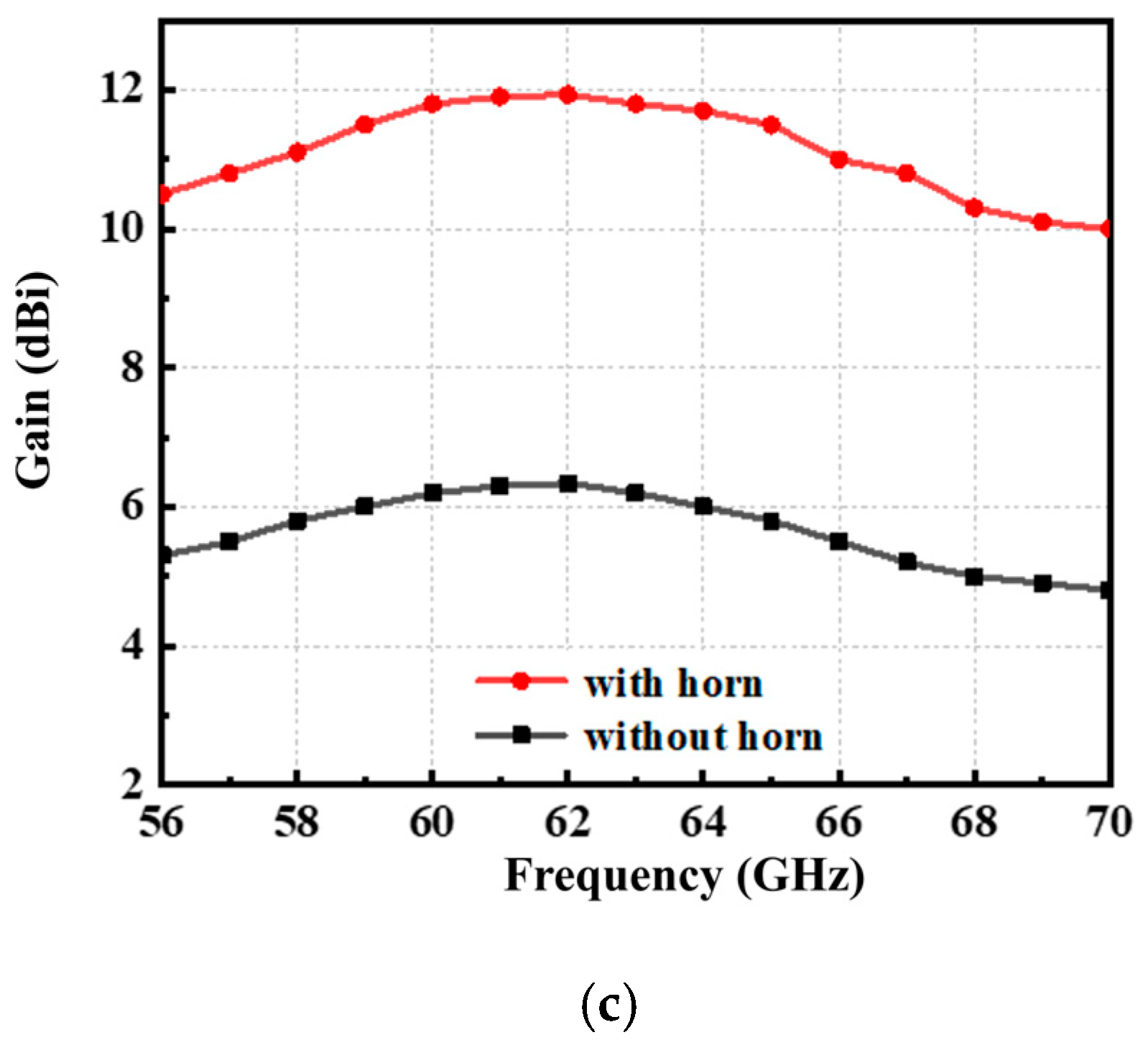
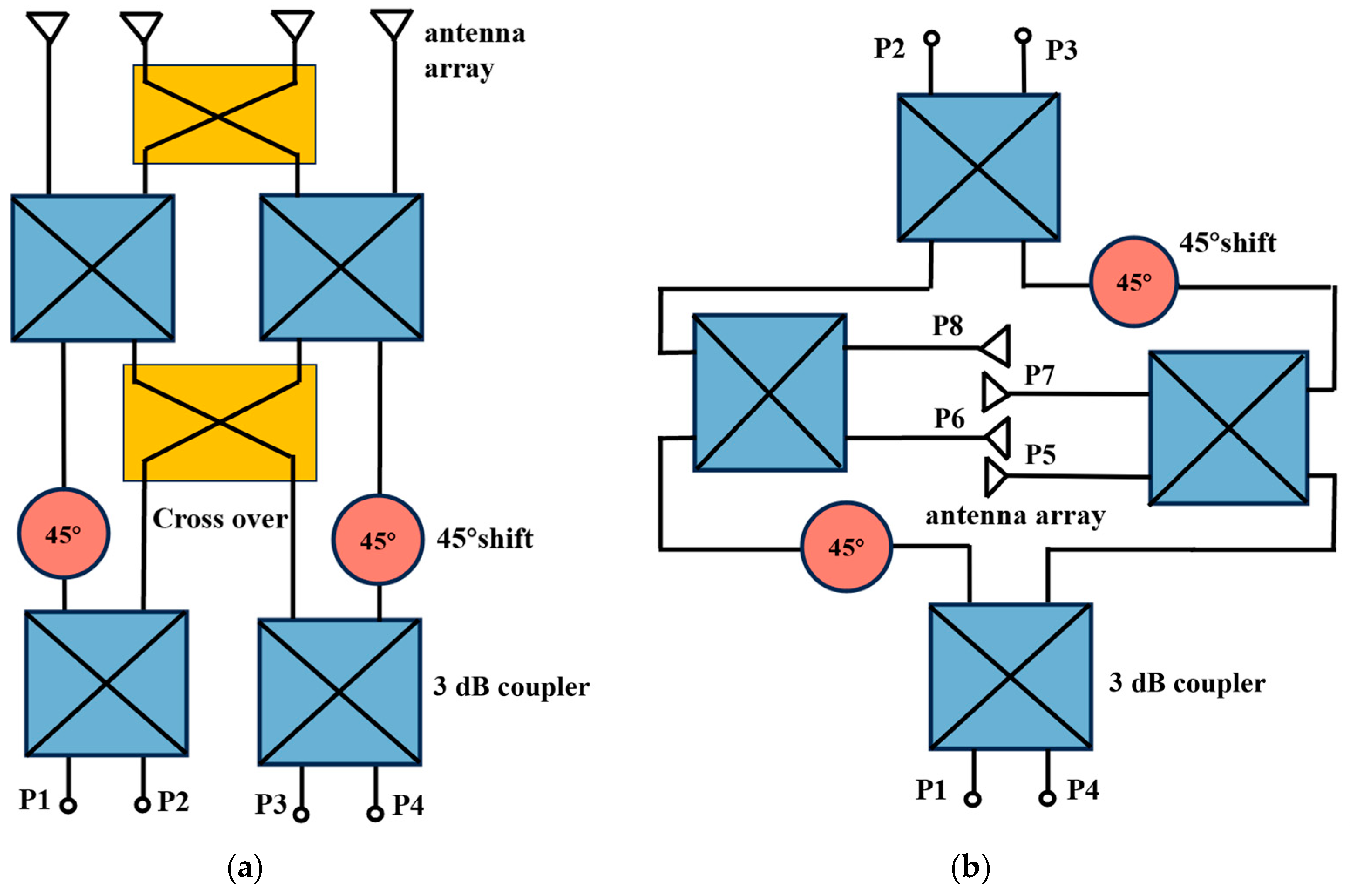
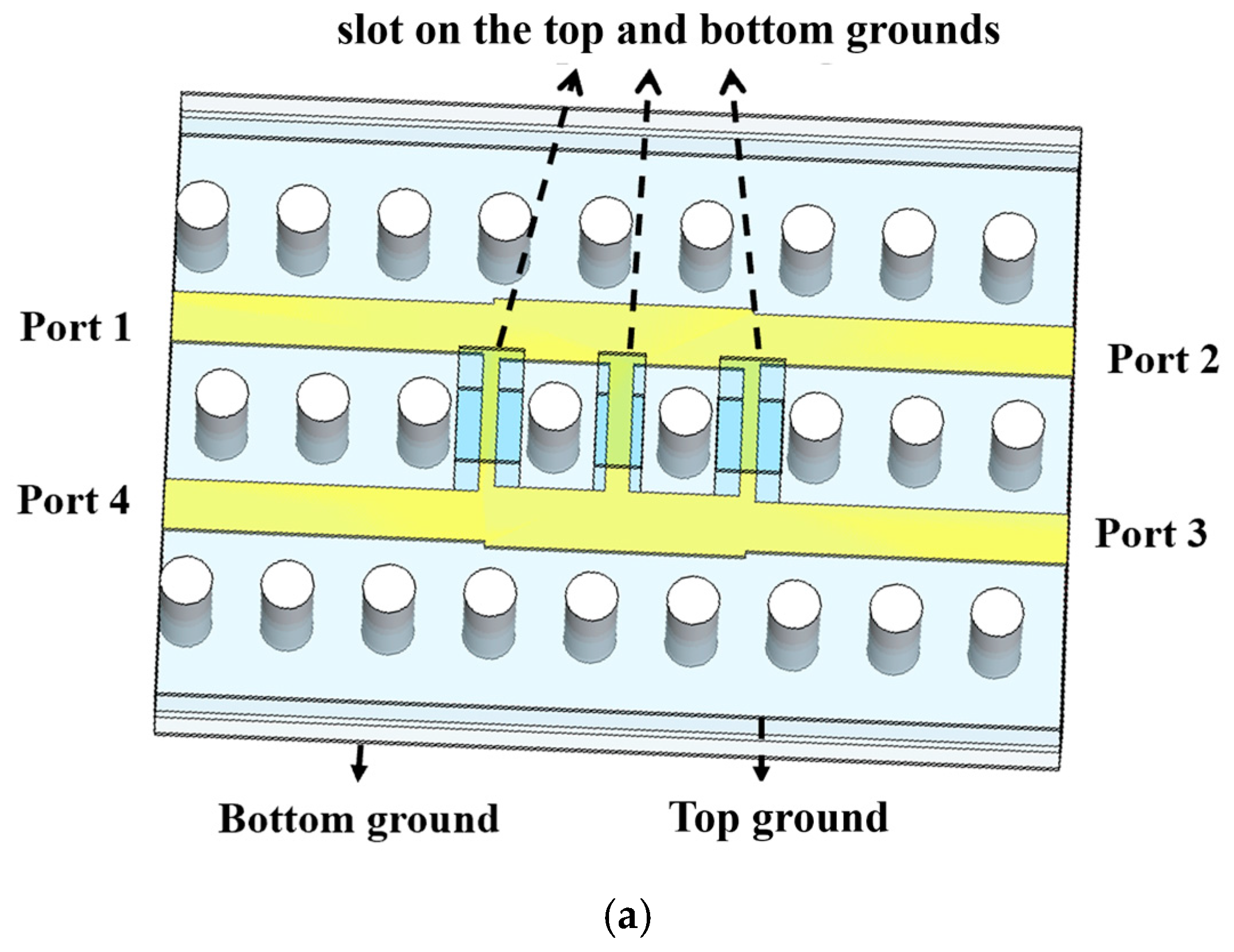


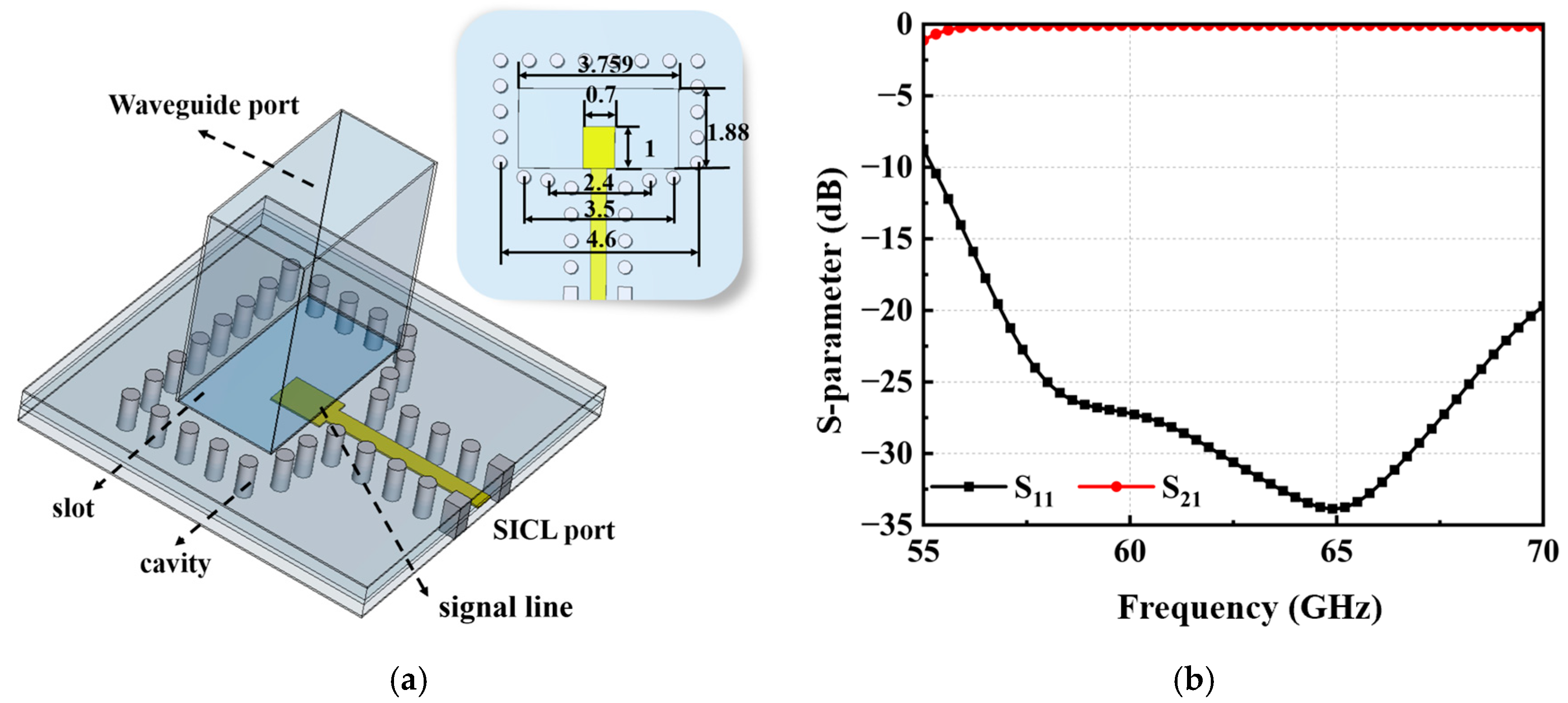
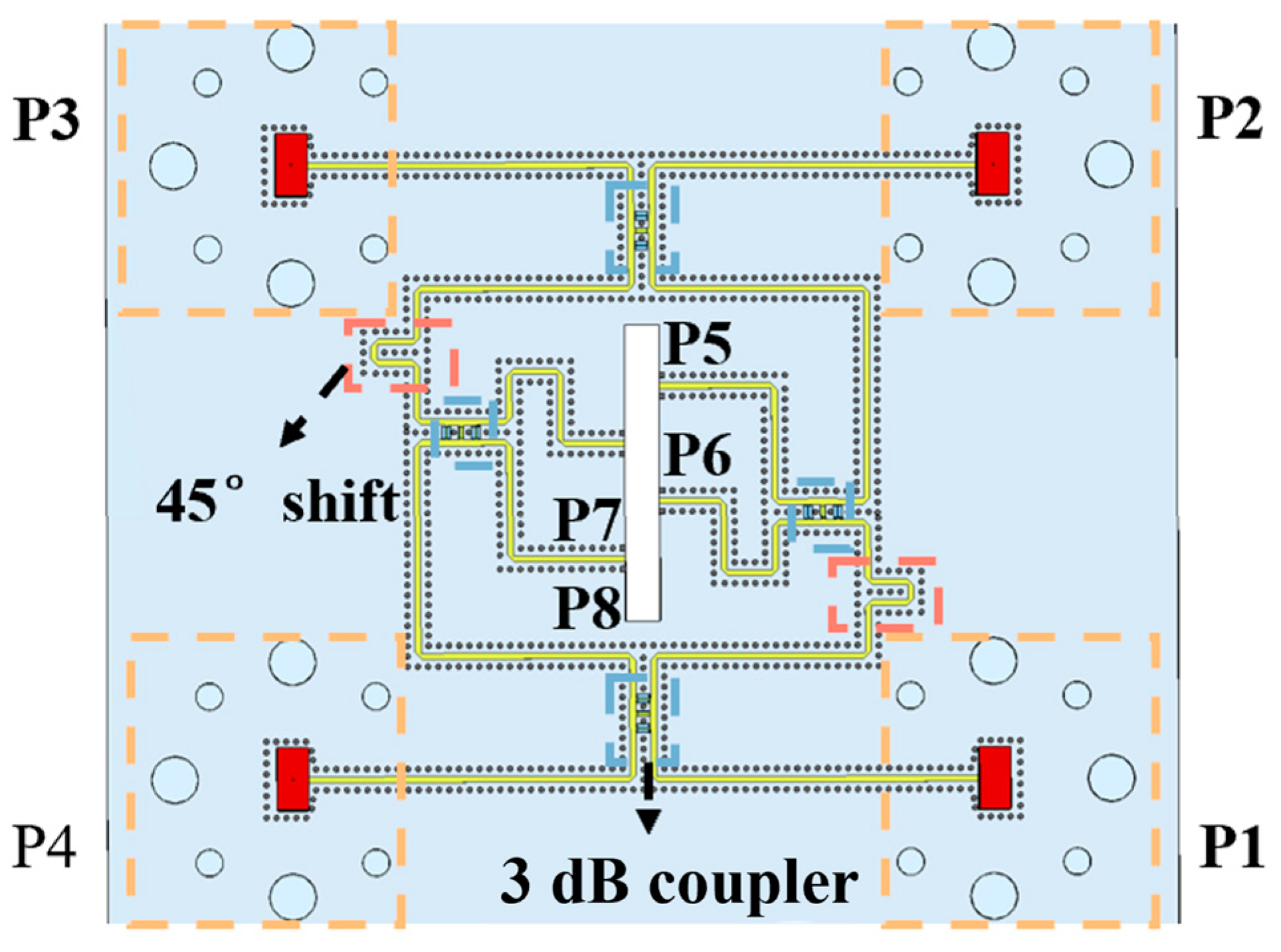
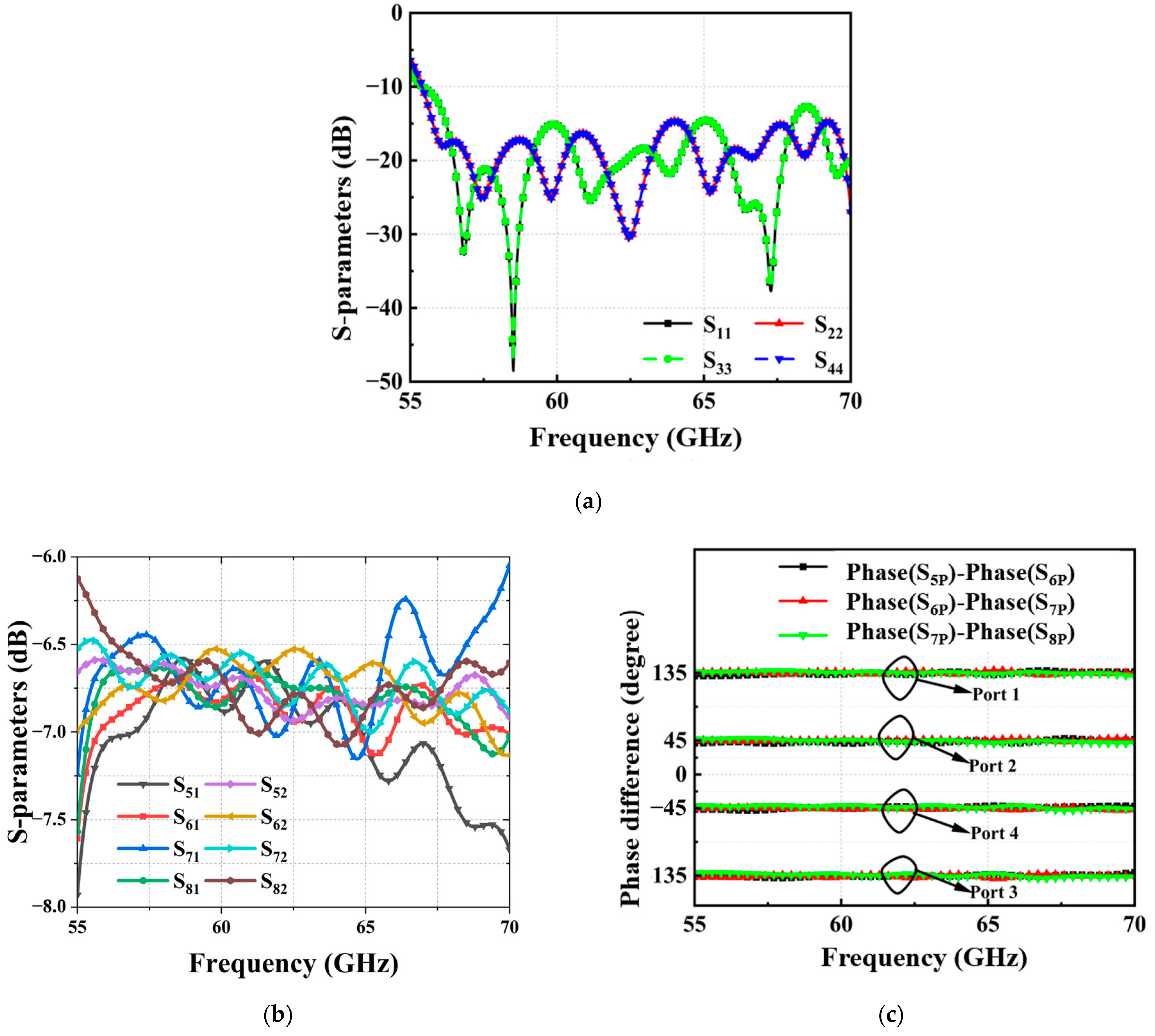
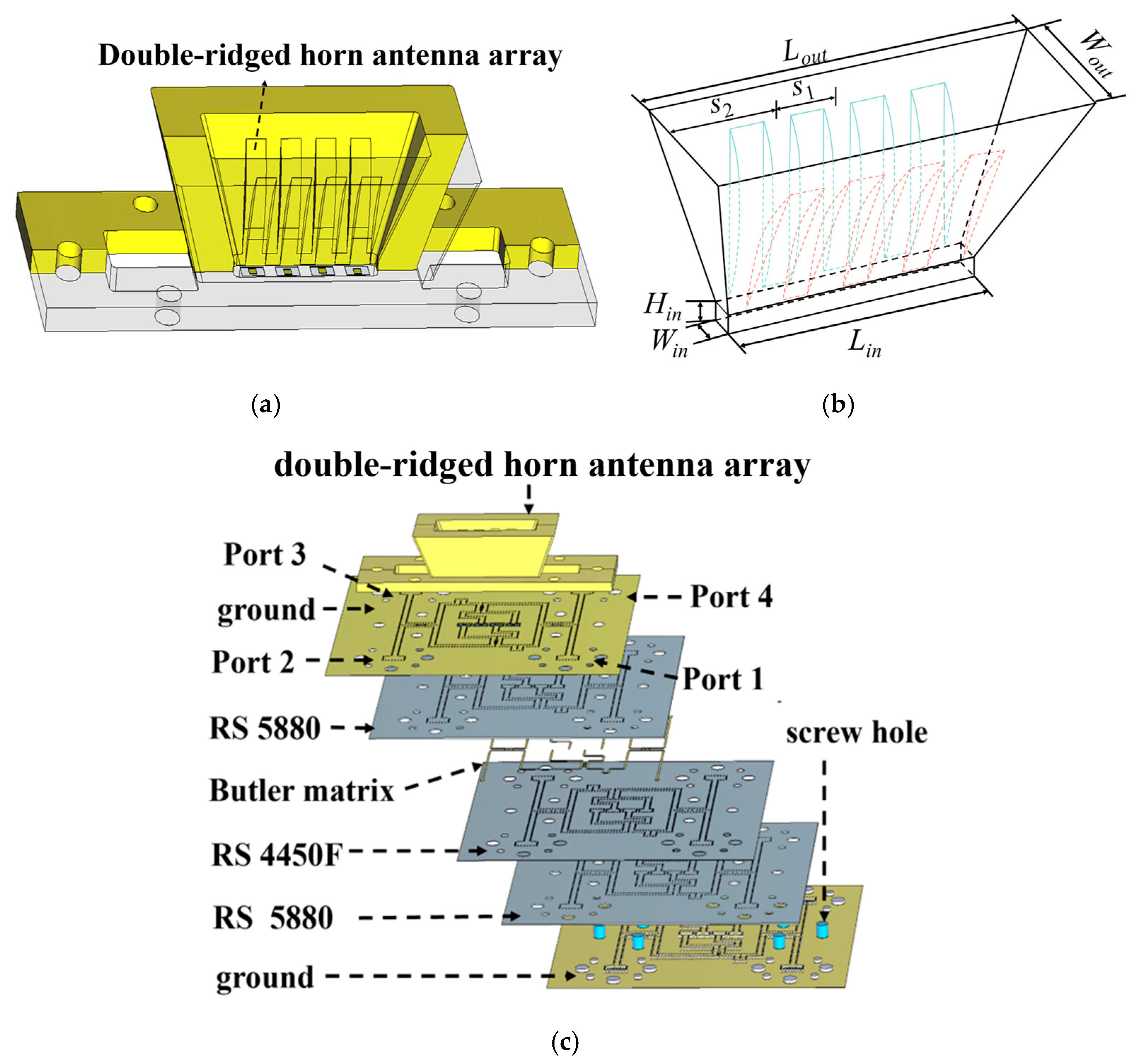
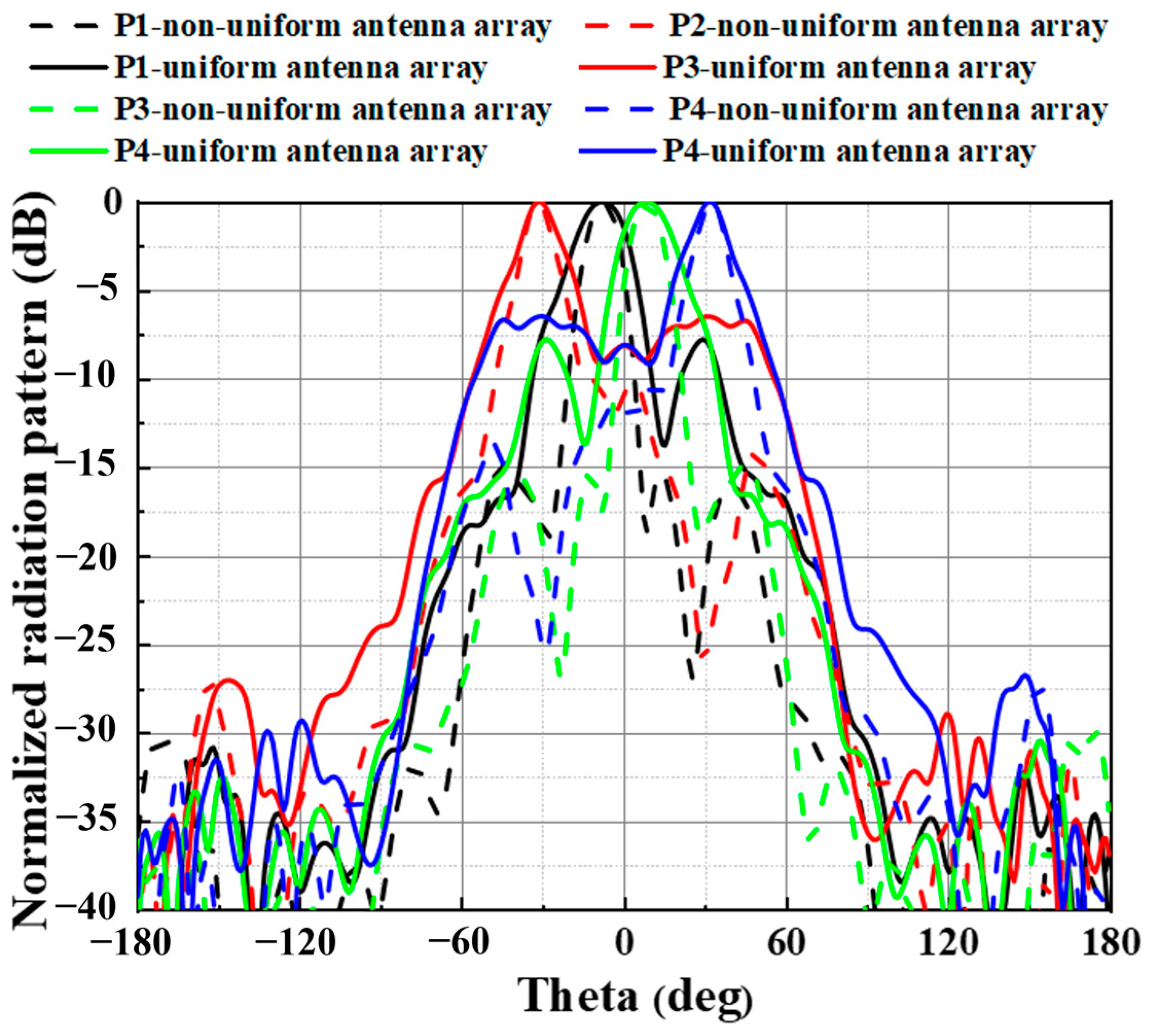



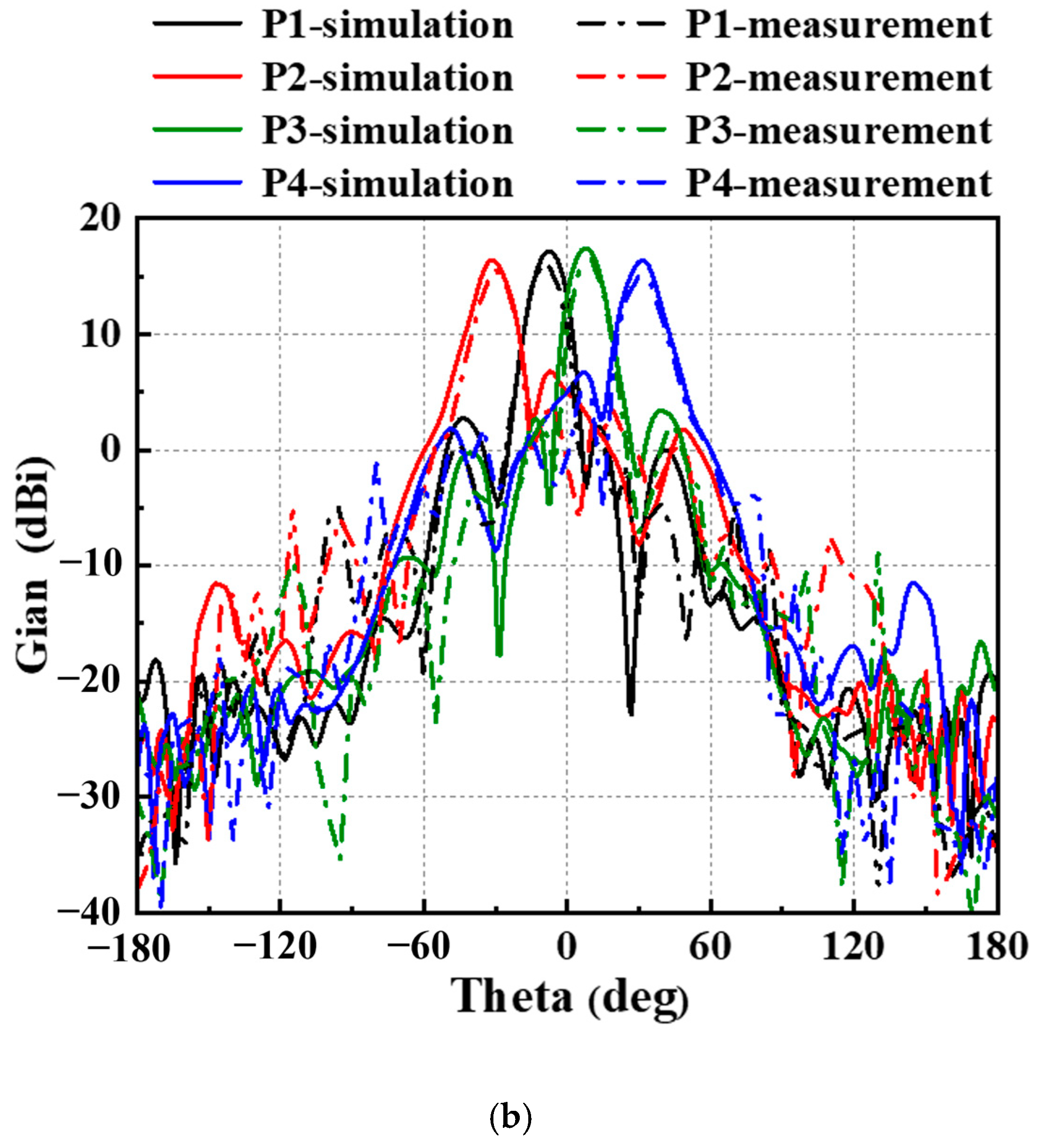
| Parameters | l1 | l2 | l3 | l4 | l5 | l6 | l7 | l8 | w1 | w2 | w3 | w4 |
| Values | 5.74 | 1.86 | 0.22 | 0.83 | 1.3 | 0.2 | 0.59 | 7.18 | 2.83 | 2.3 | 0.73 | 2.11 |
| Parameters | w5 | w6 | d1 | d2 | d3 | d4 | d5 | θr | s | l | w | d |
| Values | 0.36 | 0.25 | 6 | 10 | 3 | 7 | 1.7 | 24° | 7.32 | 15 | 3.5 | 2 |
| Parameters | Cw1 | Cw2 | Cw3 | Cw4 | CL1 | CL2 | Sw1 | Sw1 | SL |
| Values | 0.33 | 0.23 | 0.1 | 0.22 | 1.82 | 0.92 | 0.21 | 0.29 | 0.75 |
| Parameters | Lout | Wout | Hin | Lin | Win | S1 | S2 |
| Values | 22 | 7 | 1 | 14.5 | 1.7 | 3.5 | 4 |
| Ref. | Type | BM | Size (λg) | Bandwidth | Gain (dBi) | Beam (°) |
|---|---|---|---|---|---|---|
| [4] | MS | 1 × 4 | 6 × 6 × 0.03 | 8.83%(@60GHz) | 7.7~8.9 | ±14, ±40 |
| [5] | SIW | 4 × 4 | 11 × 4.2 × 0.05 | 13%(@30GHz) | 9.7~12 | ±12, ±51 |
| [10] | SIW | 4 × 4 | 37.5 × 24 | 22.5%(@37.5GHz) | 10.4–12.8 | ±13, ±38 |
| [15] | RGW | 4 × 4 | 9 × 5.4 | 21.25%(@30GHz) | 10.2~11.3 | ±13, ±36 |
| [16] | RGW | 4 × 4 | 14.4 × 26 × 0.6 | 21.5%(@61.5GHz) | 25.1~26.3 | ±17, ±43 |
| This work | SICL | 4 × 4 | 11 × 10 × 2.03 | 23.3%(@62GHz) | 15.1~16.5 | −30°, −9°, 10°, 32° |
Disclaimer/Publisher’s Note: The statements, opinions and data contained in all publications are solely those of the individual author(s) and contributor(s) and not of MDPI and/or the editor(s). MDPI and/or the editor(s) disclaim responsibility for any injury to people or property resulting from any ideas, methods, instructions or products referred to in the content. |
© 2025 by the authors. Licensee MDPI, Basel, Switzerland. This article is an open access article distributed under the terms and conditions of the Creative Commons Attribution (CC BY) license (https://creativecommons.org/licenses/by/4.0/).
Share and Cite
Hua, Z.; Gao, C.; Peng, J.; Fan, S.; Qian, Z. A Compact and Wideband Beam-Scanning Antenna Array Based on SICL Butler Matrix. Electronics 2025, 14, 757. https://doi.org/10.3390/electronics14040757
Hua Z, Gao C, Peng J, Fan S, Qian Z. A Compact and Wideband Beam-Scanning Antenna Array Based on SICL Butler Matrix. Electronics. 2025; 14(4):757. https://doi.org/10.3390/electronics14040757
Chicago/Turabian StyleHua, Zhu, Chuang Gao, Jiejun Peng, Shuting Fan, and Zhengfang Qian. 2025. "A Compact and Wideband Beam-Scanning Antenna Array Based on SICL Butler Matrix" Electronics 14, no. 4: 757. https://doi.org/10.3390/electronics14040757
APA StyleHua, Z., Gao, C., Peng, J., Fan, S., & Qian, Z. (2025). A Compact and Wideband Beam-Scanning Antenna Array Based on SICL Butler Matrix. Electronics, 14(4), 757. https://doi.org/10.3390/electronics14040757






